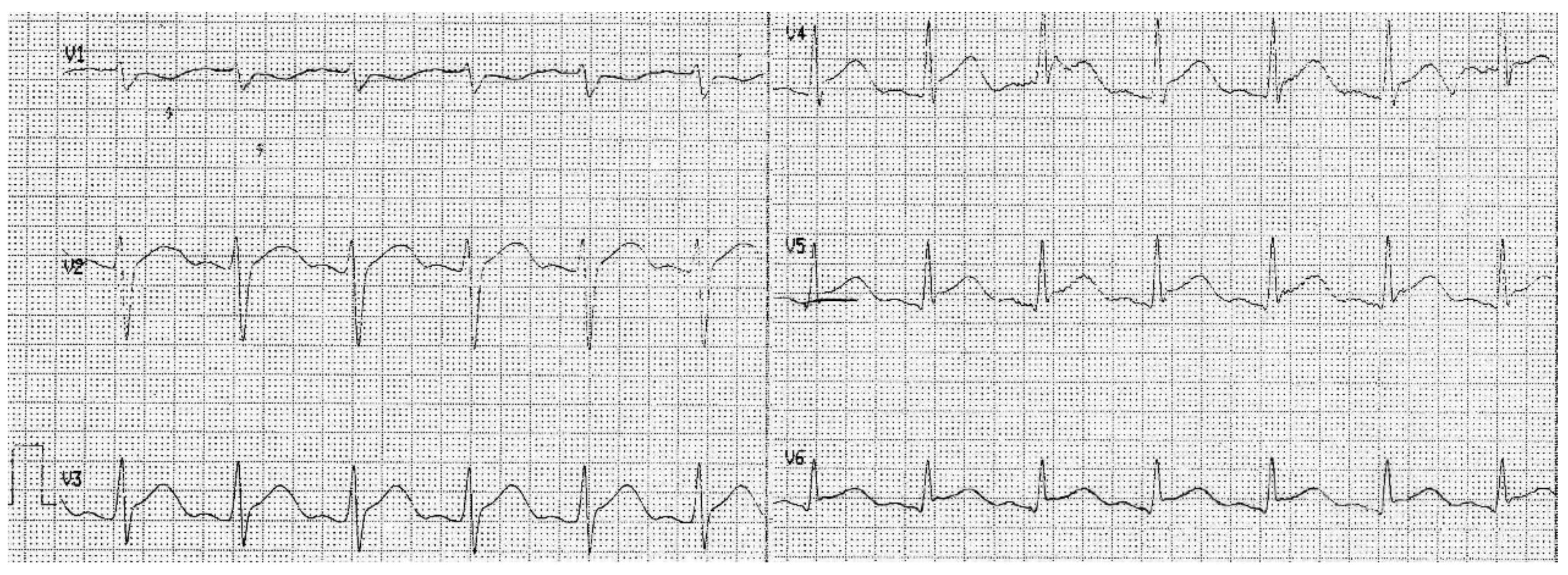Successful Treatment with Corticosteroids in an 11-Year-Old Patient with Crohn’s Disease and Myopericarditis—Case Report
Abstract
:1. Introduction
2. Case Report
3. Discussion
4. Conclusions
Author Contributions
Funding
Institutional Review Board Statement
Informed Consent Statement
Data Availability Statement
Conflicts of Interest
References
- Kindermann, I.; Barth, C.; Mahfoud, F.; Ukena, C.; Lenski, M.; Yilmaz, A.; Klingel, K.; Kandolf, R.; Sechtem, U.; Cooper, L.T.; et al. Update on myocarditis. J. Am. Coll. Cardiol. 2012, 59, 779–792. [Google Scholar] [CrossRef]
- Magnani, J.W.; Dec, G.W. Myocarditis current trends in diagnosis and treatment. Circulation 2006, 113, 876–890. [Google Scholar] [CrossRef] [Green Version]
- Jose, F.A.; Heyman, M.B. Extraintestinal Manifestations of Inflammatory Bowel Disease. J. Pediatr. Gastroenterol. Nutr. 2008, 46, 124–133. [Google Scholar] [CrossRef] [Green Version]
- Frid, C.; Bjarke, B.; Eriksson, M. Myocarditis in Children with Inflammatory Bowel Disease. J. Pediatr. Gastroenterol. Nutr. 1986, 5, 964–965. [Google Scholar] [CrossRef]
- Patwardhan, R.V.; Heilpern, R.J.; Brewster, A.C.; Darrah, J.J. Pleuropericarditis: An Extraintestinal Complication of Inflammatory Bowel Disease. Arch. Intern. Med. 1983, 143, 94–96. [Google Scholar] [CrossRef]
- Agnholt, J.O.R.; Sørensen, H.T.; Rasmussen, S.N.; Gøtzsche, C.O.; Halkier, P.; Srensen, H.T.; Gtzsche, C.-O. Cardiac Hypersensitivity to 5-Aminosalicylic Acid. Lancet 1989, 333, 1135. [Google Scholar] [CrossRef]
- Gujral, N.; Friedenberg, F.; Friedenberg, J.; Gabriel, G.; Kotler, M.; Levine, G. Pleuropericarditis related to the use of mesalamine. Dig. Dis. Sci. 1996, 41, 624–626. [Google Scholar] [CrossRef]
- Galvao Braga, C.; Martins, J.; Arantes, C.; Ramos, V.; Vieira, C.; Salgado, A.; Magalhães, S.; Correia, A. Mesalamine-induced myocarditis following diagnosis of Crohn’s disease: A case report. Rev. Port. Cardiol. 2013, 32, 717–720. [Google Scholar] [CrossRef]
- Nair, A.G.; Cross, R.R. Mesalamine-induced myopericarditis in a paediatric patient with Crohn’s disease. Cardiol. Young 2015, 25, 783–786. [Google Scholar] [CrossRef]
- Liu, Y.; Ye, J.; Zhu, J.; Chen, W.; Sun, Y. Myocarditis due to mesalamine treatment in a patient with Crohn’s disease in China. Turk. J. Gastroenterol. 2012, 23, 304–306. [Google Scholar] [CrossRef]
- Lakatos, L.; Pandur, T.; David, G.; Balogh, Z.; Kuronya, P.; Tollas, A.; Lakatos, P.L. Association of extraintestinal manifestations of inflammatory bowel disease in a province of western Hungary with disease phenotype: Results of 25-year follow-up study. World J. Gastroenterol. 2003, 9, 2300–2307. [Google Scholar] [CrossRef]
- Murphy, K.; Waldo, O.; Lohrmann, G.M.; Tazelaar, H.D.; Jokerst, C.E.; Mookadam, F. Eosinophilia and ulcerative colitis associated with eosinophilis myocarditis. Tex. Heart Inst. J. 2017, 44, 219–222. [Google Scholar] [CrossRef] [Green Version]
- Cooper, L.; Baughman, K.L.; Feldman, A.M.; Frustaci, A.; Jessup, M.; Kuhl, U.; Levine, G.N.; Narula, J.; Starling, R.C.; Towbin, J.; et al. The role of endomyocardial biopsy in the management of cardiovascular disease: A Scientific Statement from the American Heart Association, the American College of Cardiology, and the European Society of Cardiology Endorsed by the Heart Failure Society of America and the Heart Failure Association of the European Society of Cardiology. Eur. Heart J. 2007, 28, 3076–3093. [Google Scholar] [CrossRef]
- Leslie, T.; Cooper, M.D., Jr. Myocarditis. N. Engl. J. Med. 2009, 360, 1526–1538. [Google Scholar]
- McGrath-Cadell, L.; Bart, N.K.; Lin, L.; Ghaly, S.; Holloway, C.J. Myocarditis in Crohn’s disease: A case report. Eur. Heart J. Case Rep. 2020, 4, 1–6. [Google Scholar] [CrossRef]
- Kumar, M.; Tandon, V.; Mosebach, C.M.; Lopetegui Lia, N.; Miller, W. Acute Myopericarditis with Crohn’s Disease Flare-up. Cureus 2019, 11, e4248. [Google Scholar] [CrossRef] [Green Version]
- Freeman, H.J.; Salh, B. Recurrent myopericarditis with extensive ulcerative colitis. Can. J. Cardiol. 2010, 26, 549–550. [Google Scholar] [CrossRef] [Green Version]
- Gruenhagen, B.; Alraies, M.C.; Vakil, K.P.; March, S.K. Ulcerative colitis-induced myocarditis. BMJ Case Rep. 2014, 2014, bcr2014204818. [Google Scholar] [CrossRef] [Green Version]
- Van Gils, A.J.; van Gijlswijk, S.; Taminiau, J.A.; Marchau, F.; Van De Vijver, E. Recurrent pericarditis as an extra-intestinal manifestation of ulcerative colitis in 14-year old girl. Clin. Case Rep. 2018, 6, 1538–1542. [Google Scholar] [CrossRef] [Green Version]
- Okoro, K.U.; Roby, M.D.; Bankole, A.A. Myocarditis secondary to mesalamine- induced cardiotoxicity in a patient with ulcerative colitis. Case Rep. Med. 2018, 2018, 9813893. [Google Scholar] [CrossRef]
- Oh, I.S.; Choi, C.H.; Park, J.H.; Kim, J.W.; Cha, B.K.; Do, J.H.; Chang, S.K.; Kwon, G.Y. A case of acute myocarditis as the initial presentation of Crohn’s disease. Gut Liver 2012, 6, 512–515. [Google Scholar] [CrossRef] [Green Version]
- Reichardt, P.; Dähnert, I.; Tiller, G.; Häusler, H.J. Possibile activation of an intramyocardial inflammatory process (Staphylococcus ureus) after treatment with infliximab in a boy with Crohn disease. Eur. J. Pediatr. 2002, 161, 281–283. [Google Scholar] [CrossRef]
- Lezcano-Gort, L.E.; Gomez-Barrado, J.J.; Mogollon-Jimenez, M.V.; Garcipérez-de-Vargas-Díaz, F.J. Hypersensitivity perimyocarditis after the first dose of infliximab. Rev. Esp. Enferm. Dig. 2015, 107, 249. [Google Scholar]



Publisher’s Note: MDPI stays neutral with regard to jurisdictional claims in published maps and institutional affiliations. |
© 2022 by the authors. Licensee MDPI, Basel, Switzerland. This article is an open access article distributed under the terms and conditions of the Creative Commons Attribution (CC BY) license (https://creativecommons.org/licenses/by/4.0/).
Share and Cite
Ryzko, J.; Zdanowicz, K.; Lebensztejn, D.M.; Daniluk, U. Successful Treatment with Corticosteroids in an 11-Year-Old Patient with Crohn’s Disease and Myopericarditis—Case Report. Pediatr. Rep. 2022, 14, 26-31. https://doi.org/10.3390/pediatric14010005
Ryzko J, Zdanowicz K, Lebensztejn DM, Daniluk U. Successful Treatment with Corticosteroids in an 11-Year-Old Patient with Crohn’s Disease and Myopericarditis—Case Report. Pediatric Reports. 2022; 14(1):26-31. https://doi.org/10.3390/pediatric14010005
Chicago/Turabian StyleRyzko, Joanna, Katarzyna Zdanowicz, Dariusz Marek Lebensztejn, and Urszula Daniluk. 2022. "Successful Treatment with Corticosteroids in an 11-Year-Old Patient with Crohn’s Disease and Myopericarditis—Case Report" Pediatric Reports 14, no. 1: 26-31. https://doi.org/10.3390/pediatric14010005





